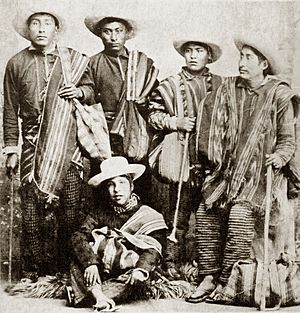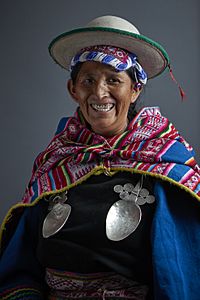Kallawaya facts for kids
The Kallawaya are a special group of traditional healers from the Andes mountains in Bolivia. They are known for traveling to different places to help sick people. They live in a mountainous area north of La Paz, called the Bautista Saavedra region.
The Kallawaya people are part of the ancient Mollo culture and are directly linked to the even older Tiwanaku culture. Their history as healers goes back to before the Inca times. The Kallawaya were very skilled. They knew how to prevent and treat malaria using a medicine called quinine even before Europeans did. They also performed complex operations like brain surgery! They even helped save many lives when the Panama Canal was being built. In 2012, there were about 11,662 Kallawaya people living in Bolivia.
Contents
Kallawaya Healers: Ancient Wisdom
Kallawaya doctors, also called médicos Kallawaya, are famous for their healing skills. They were even the personal healers for Inca kings! They are like living libraries of scientific knowledge, especially about the healing powers of plants, animals, and minerals.
Most Kallawaya healers know how to use about 300 different herbs. Some very skilled specialists know as many as 600 herbs! Kallawaya women often work as midwives, helping with childbirth. They also treat women's health issues and care for children.
Traveling to Help the Sick
Kallawaya healers travel far and wide to help people. They go through northwestern Bolivia and even to parts of Argentina, Chile, Ecuador, Panama, and Peru. Often, they walk along old Inca trails. They journey through tropical forests, mountain valleys, and high plateaus. As they travel, they search for traditional herbs.
Before they leave home to heal, Kallawaya healers perform a special ceremonial dance. This dance and their unique clothing are part of being a yatiri, which means "healer." Their special clothing includes a llantucha made of rhea feathers. This helps protect them from the weather during their travels. They carry khapchos, which are special bags for men. These bags hold their herbs, mixes, and good luck charms.
Music and Spirits
Groups of musicians play traditional Kantu music during these ceremonies. They use drums and pan flutes. This music helps the healers connect with the spirit world before they visit their patients. It's an important part of their healing traditions.
The Kallawaya Language
The Kallawaya have a secret language they use for their healing work. It's called the Kallawaya language. This language uses Quechua grammar, but it has many special words for medicinal knowledge. These unique words are believed to come from an old language called Puquina, which no longer exists. For everyday conversations, the Kallawaya people speak the more common Quechua language.
See also
In Spanish: Cultura kallawaya para niños



